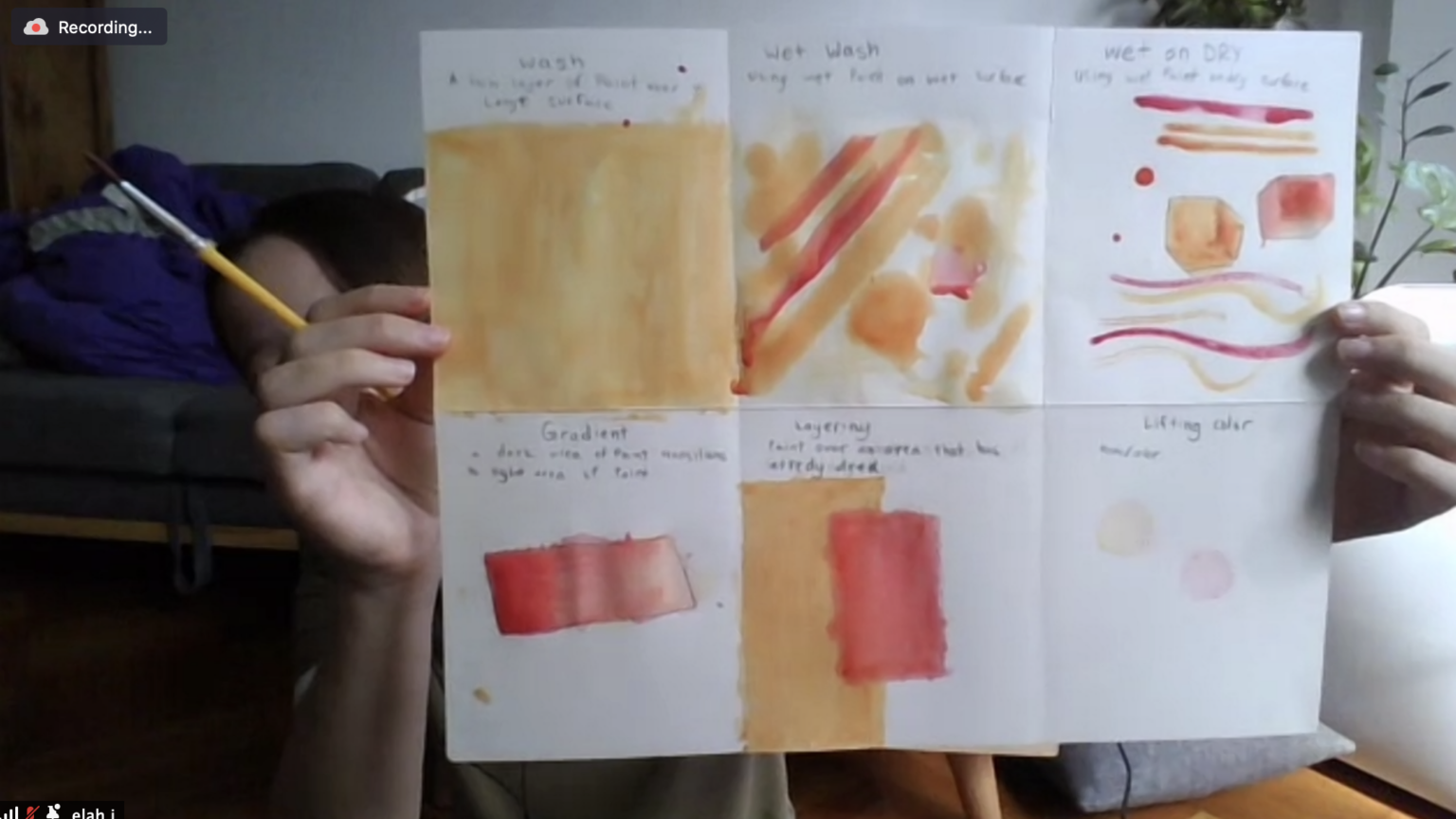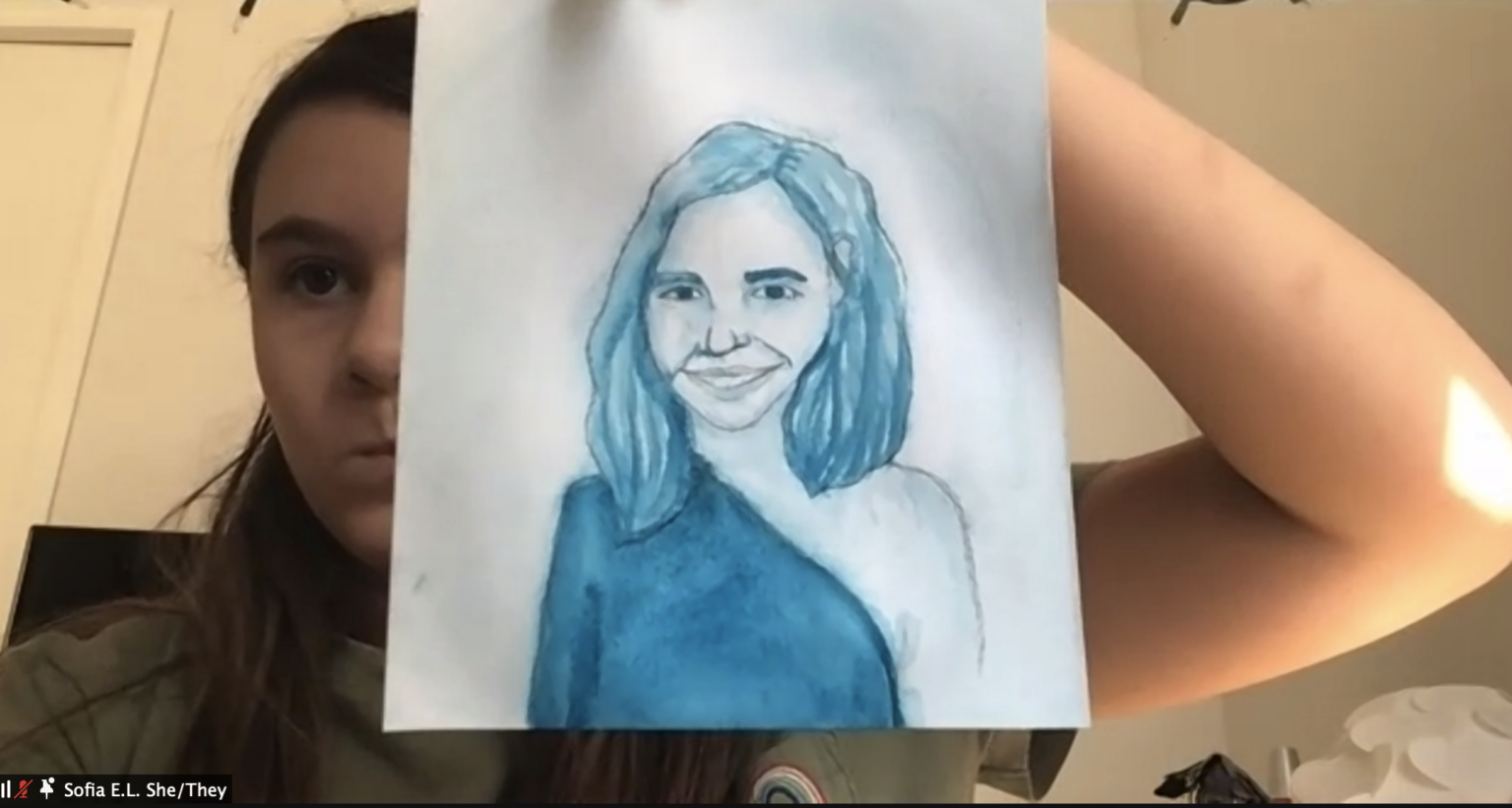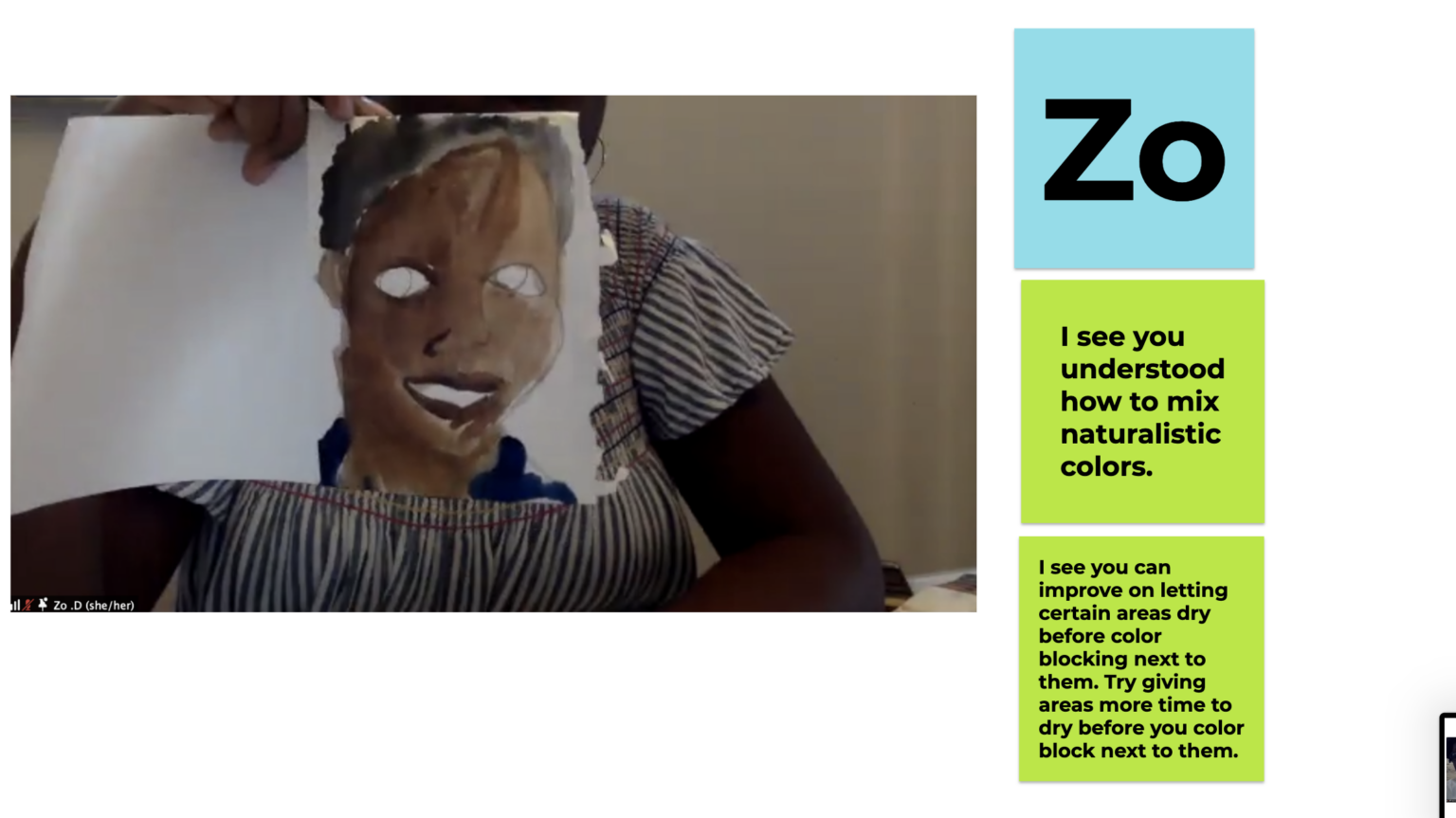Education during the Covid 19 Pandemic: an exploration of the impacts of the online transition on teaching and learning
Elise Bravate
This thesis by Elise Bravate was conducted as a part of Pratt ADE's capstone class, Curating Learning.
Curating Learning showcases the work of ADE seniors at the culmination of the program as they curate their experiences as artists, cultural producers, and learners. The research projects and related artworks created, emphasize student interdisciplinary connections and reflections on how knowledge is constructed and facilitated through teaching, learning, and curating.
Students integrate theory and practice through reflection and research in the field of art and design education. Students develop their voices as emerging professionals as they synthesize their learning in studio, liberal arts, art and design education, and pre-service teaching as well as co-curricular experiences in both formal and informal settings. Working across media and informed by their own research they created projects that ultimately highlight their perspective on integrating their learning across the studio, classroom, and community.
Exhibition Statement:
Through my research I have looked into the question “how has covid-19 affected education?" My research addresses the following issues: “how has online learning affected teachers/students?” and “what are the benefits/drawbacks to teaching now vs before the pandemic?”
Through a series of interviews and survey responses, I compiled statistics regarding how teaching/learning in New York public schools have been affected after having spent almost a year with online learning as a result of the pandemic. I looked into not only the hardships that this pandemic has caused for the individuals working hard to thrive in these circumstances, but also the benefits that have come from it.
As someone who is both teaching and learning online at the time of the pandemic, this research topic is personal to me and this study has also found ways to highlight how education in NY schools has grown/evolved rather than ways it has been stunted as a result of covid-19.
Throughout my research I have come to find that the majority of teachers prefer in person learning. Many teachers found that online learning created a larger learning gap as well as decreased students' success and engagement within the classroom. In terms of technology, teachers found a ton of problems regarding student accessibility and capability. This sharp transition to a new platform created many technological difficulties for students and teachers alike, especially early on. Teachers also mentioned that they felt socially isolated, they missed interacting face to face with colleagues and students. Many of them also pointed out that this entire transition to online learning has affected them personally and emotionally in a negative way. The primary benefit teachers found for online learning was the fact that it allowed them to continue doing their jobs from the safety of their homes during the pandemic. They also found it helped them to become more proficient in technology and online platforms in a way that they will be able to utilize in their lessons from here on out. Throughout all of my interviews, all of my findings point to educators strongly preferring the traditional in person teaching format compared to online learning. Teachers largely recognize in person learning as being the most effective and efficient way to educate students. These teachers perceive that students would agree with the structure of in person classes being superior to online classes. The teachers recorded: better grades from their students, better energy levels and moods from their students, less distractions from their students, more direct/clear understanding from their students, and more participation/involvement from their students when classes were being held in person compared to online.
While it certainly was necessary to transition education to an online format in order to keep everyone safe during the global pandemic, it has created widespread damage for teachers and students. This transition to online learning was jarring and abrupt which made it far less manageable compared to how it could have been if there was more time to prepare and organize everything. The trauma and fear related to the global pandemic that changed everyone’s lives is hard enough to manage outside of having to relearn an entire new format for teaching and learning.
The pandemic is not over and online learning is still in place, luckily as of March 2021 the vaccines are being distributed and schools will hopefully return to normal soon. We likely won’t have concrete data for the pandemics effects on education for years to come in order to record the long term effects, but all research on the topic will contribute to data as years go on.
Curating Learning showcases the work of ADE seniors at the culmination of the program as they curate their experiences as artists, cultural producers, and learners. The research projects and related artworks created, emphasize student interdisciplinary connections and reflections on how knowledge is constructed and facilitated through teaching, learning, and curating.
Students integrate theory and practice through reflection and research in the field of art and design education. Students develop their voices as emerging professionals as they synthesize their learning in studio, liberal arts, art and design education, and pre-service teaching as well as co-curricular experiences in both formal and informal settings. Working across media and informed by their own research they created projects that ultimately highlight their perspective on integrating their learning across the studio, classroom, and community.
Exhibition Statement:
Through my research I have looked into the question “how has covid-19 affected education?" My research addresses the following issues: “how has online learning affected teachers/students?” and “what are the benefits/drawbacks to teaching now vs before the pandemic?”
Through a series of interviews and survey responses, I compiled statistics regarding how teaching/learning in New York public schools have been affected after having spent almost a year with online learning as a result of the pandemic. I looked into not only the hardships that this pandemic has caused for the individuals working hard to thrive in these circumstances, but also the benefits that have come from it.
As someone who is both teaching and learning online at the time of the pandemic, this research topic is personal to me and this study has also found ways to highlight how education in NY schools has grown/evolved rather than ways it has been stunted as a result of covid-19.
Throughout my research I have come to find that the majority of teachers prefer in person learning. Many teachers found that online learning created a larger learning gap as well as decreased students' success and engagement within the classroom. In terms of technology, teachers found a ton of problems regarding student accessibility and capability. This sharp transition to a new platform created many technological difficulties for students and teachers alike, especially early on. Teachers also mentioned that they felt socially isolated, they missed interacting face to face with colleagues and students. Many of them also pointed out that this entire transition to online learning has affected them personally and emotionally in a negative way. The primary benefit teachers found for online learning was the fact that it allowed them to continue doing their jobs from the safety of their homes during the pandemic. They also found it helped them to become more proficient in technology and online platforms in a way that they will be able to utilize in their lessons from here on out. Throughout all of my interviews, all of my findings point to educators strongly preferring the traditional in person teaching format compared to online learning. Teachers largely recognize in person learning as being the most effective and efficient way to educate students. These teachers perceive that students would agree with the structure of in person classes being superior to online classes. The teachers recorded: better grades from their students, better energy levels and moods from their students, less distractions from their students, more direct/clear understanding from their students, and more participation/involvement from their students when classes were being held in person compared to online.
While it certainly was necessary to transition education to an online format in order to keep everyone safe during the global pandemic, it has created widespread damage for teachers and students. This transition to online learning was jarring and abrupt which made it far less manageable compared to how it could have been if there was more time to prepare and organize everything. The trauma and fear related to the global pandemic that changed everyone’s lives is hard enough to manage outside of having to relearn an entire new format for teaching and learning.
The pandemic is not over and online learning is still in place, luckily as of March 2021 the vaccines are being distributed and schools will hopefully return to normal soon. We likely won’t have concrete data for the pandemics effects on education for years to come in order to record the long term effects, but all research on the topic will contribute to data as years go on.
Artist Statement
Artist’s Statement:
My artwork has developed over time from meticulous observational renderings of life forms and their surroundings into a body of surreal work that emphasizes character design. Much of my work relates to myself as well as personal experiences in my life. I often relate my work to my emotions, memories, and experiences through paintings/drawings. I do understand that everyone who will look at my work will view it in a lense of their own personal biases and experiences, therefore making it likely that each person may interpret different meanings from my work. Each piece does not have one meaning, nor is it locked in the meaning I intended before/during its creation. Each painting is open and I welcome interpretations, it helps me expand my work, it helps me further my work. Overall it helps me improve my ongoing and next pieces.
In my work I often reference the human figure and concepts related to identity as well as the human form. The figures I work with are usually full body depictions of people, often semi-realistically depicted but also sometimes the proportions/colors/details are altered in order to create a certain mood or get a point across. My interest in the human form began with a desire to learn how to create realistic/academic illustrations of the human body, but after years of practice it became one of the most crucial parts to my work. My work spans across media, primarily consisting of drawings and paintings. I prefer to work in oil paint but due to its many limitations such as drying time and harsh chemicals requiring proper ventilation I don't get to work with it as often as I would like, especially in times like the current pandemic/quarantine. As a result of this, I end up using more watercolors and acrylic paints due to its accessibility.
When looking at art, people tend to project their own stories and identities onto what they see, connecting to the work personally, and seeing themselves in it. I want my art to intrigue the viewer, causing them to think deeper, beyond what is depicted on the surface. I want them to look into the work and come up with their own stories and meanings. I often try to keep my work from being too literal, or from spelling out what it means without having to put any thought into it.
My artwork has developed over time from meticulous observational renderings of life forms and their surroundings into a body of surreal work that emphasizes character design. Much of my work relates to myself as well as personal experiences in my life. I often relate my work to my emotions, memories, and experiences through paintings/drawings. I do understand that everyone who will look at my work will view it in a lense of their own personal biases and experiences, therefore making it likely that each person may interpret different meanings from my work. Each piece does not have one meaning, nor is it locked in the meaning I intended before/during its creation. Each painting is open and I welcome interpretations, it helps me expand my work, it helps me further my work. Overall it helps me improve my ongoing and next pieces.
In my work I often reference the human figure and concepts related to identity as well as the human form. The figures I work with are usually full body depictions of people, often semi-realistically depicted but also sometimes the proportions/colors/details are altered in order to create a certain mood or get a point across. My interest in the human form began with a desire to learn how to create realistic/academic illustrations of the human body, but after years of practice it became one of the most crucial parts to my work. My work spans across media, primarily consisting of drawings and paintings. I prefer to work in oil paint but due to its many limitations such as drying time and harsh chemicals requiring proper ventilation I don't get to work with it as often as I would like, especially in times like the current pandemic/quarantine. As a result of this, I end up using more watercolors and acrylic paints due to its accessibility.
When looking at art, people tend to project their own stories and identities onto what they see, connecting to the work personally, and seeing themselves in it. I want my art to intrigue the viewer, causing them to think deeper, beyond what is depicted on the surface. I want them to look into the work and come up with their own stories and meanings. I often try to keep my work from being too literal, or from spelling out what it means without having to put any thought into it.
SAS Fall 2020: Watercolor portraiture lesson (middle school)
These works are from the first class I have independently taught through Pratt Institute's Saturday Art School program. I taught class every Saturday for about 10 weeks. In these 10 weeks we worked on watercolor portraits.
While getting to know my students we began with some basic drawing activities which lead us to creating 3 portrait/contour line drawings. We started with a lesson where students were introduced to a variety of watercolor techniques, then building on this knowledge we used those techniques to paint a portrait/contour drawings.
Our first portrait was a monochromatic portrait. Students would choose one color to paint their portrait, while considering contrast and value students were asked to paint this portrait. Our second portrait was a naturalistic portrait. After learning about value and contrast, student would now build on their prior knowledge and begin to add color to the paintings. These were painted realistically with natural colors.
Below you can see work from multiple different students in my class. This class was taught entirely remotely on zoom, therefore all of these images were taken as screenshots from students webcams, this is why the photo quality varies.
While getting to know my students we began with some basic drawing activities which lead us to creating 3 portrait/contour line drawings. We started with a lesson where students were introduced to a variety of watercolor techniques, then building on this knowledge we used those techniques to paint a portrait/contour drawings.
Our first portrait was a monochromatic portrait. Students would choose one color to paint their portrait, while considering contrast and value students were asked to paint this portrait. Our second portrait was a naturalistic portrait. After learning about value and contrast, student would now build on their prior knowledge and begin to add color to the paintings. These were painted realistically with natural colors.
Below you can see work from multiple different students in my class. This class was taught entirely remotely on zoom, therefore all of these images were taken as screenshots from students webcams, this is why the photo quality varies.
Education during the Covid 19 Pandemic: an exploration of the impacts of the online transition on teaching and learning
Project Examples
Student Work Examples: Monochromatic Portraits
Student Work Examples: Naturalistic Portraits
Personal Works: oil paintings, acrylic paintings, digital drawings, drawings



